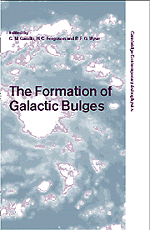Book contents
- Frontmatter
- Contents
- Preface
- Dedication: In Memory of Olin Eggen
- Part 1 Introduction
- Part 2 The Epoch of Bulge Formation
- Origin of Bulges
- Deep sub-mm Surveys: High-z ULIRGs and the Formation of Spheroids
- Ages and Metallicities for Stars in the Galactic Bulge
- Integrated Stellar Populations of Bulges: First Results
- HST-NICMOS Observations of Galactic Bulges: Ages and Dust
- Inside-Out Bulge Formation and the Origin of the Hubble Sequence
- Part 3 The Timescales of Bulge Formation
- Part 4 Physical Processes in Bulge Formation
- Part 5 Bulge Phenomenology
- Part 6 Conference Summary
- Index
Inside-Out Bulge Formation and the Origin of the Hubble Sequence
from Part 2 - The Epoch of Bulge Formation
Published online by Cambridge University Press: 10 November 2010
- Frontmatter
- Contents
- Preface
- Dedication: In Memory of Olin Eggen
- Part 1 Introduction
- Part 2 The Epoch of Bulge Formation
- Origin of Bulges
- Deep sub-mm Surveys: High-z ULIRGs and the Formation of Spheroids
- Ages and Metallicities for Stars in the Galactic Bulge
- Integrated Stellar Populations of Bulges: First Results
- HST-NICMOS Observations of Galactic Bulges: Ages and Dust
- Inside-Out Bulge Formation and the Origin of the Hubble Sequence
- Part 3 The Timescales of Bulge Formation
- Part 4 Physical Processes in Bulge Formation
- Part 5 Bulge Phenomenology
- Part 6 Conference Summary
- Index
Summary
Galactic disks are thought to originate from the cooling of baryonic material inside virialized dark halos. In order for these disks to have scalelengths comparable to observed galaxies, the specific angular momentum of the baryons has to be largely conserved. Because of the spread in angular momenta of dark halos, a significant fraction of disks are expected to be too small for them to be stable, even if no angular momentum is lost. Here it is suggested that a self-regulating mechanism is at work, transforming part of the baryonic material into a bulge, such that the remainder of the baryons can settle in a stable disk component. This inside-out bulge formation scenario is coupled to the Fall & Efstathiou theory of disk formation to search for the parameters and physical processes that determine the disk-to-bulge ratio, and therefore explain to a large extent the origin of the Hubble sequence. The Tully-Fisher relation is used to normalize the fraction of baryons that forms the galaxy, and two different scenarios are investigated for how this baryonic material is accumulated in the center of the dark halo. This simple galaxy formation scenario can account for both spirals and S0s, but fails to incorporate more bulge dominated systems.
Introduction
Despite considerable progress in our understanding of the formation of galaxies, the origin of the Hubble sequence remains a major unsolved problem. The main morphological parameter that sets the classification of galaxies in the Hubble diagram is the disk-to-bulge ratio (D/B).
- Type
- Chapter
- Information
- The Formation of Galactic Bulges , pp. 50 - 53Publisher: Cambridge University PressPrint publication year: 2000



